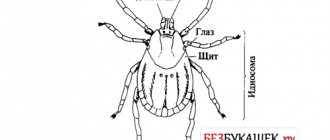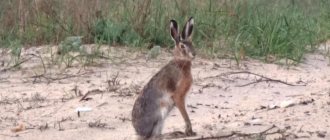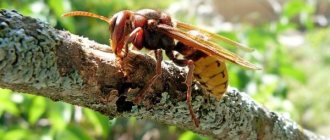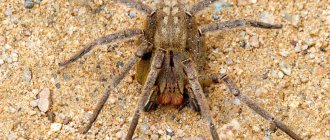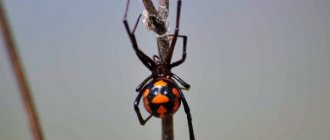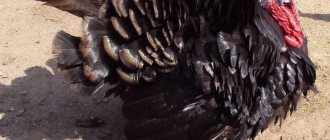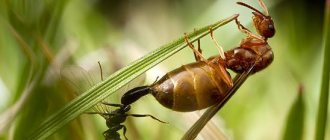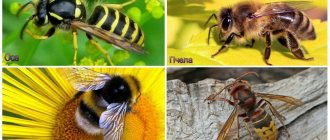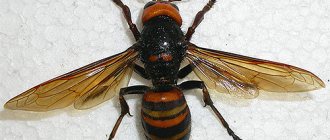Description of the Asian hornet
Giant hornet.
The Asian variety is much larger than the European one. For the most part they are similar. However, upon closer inspection, some differences are visible. The body is yellow, but with thicker black stripes. The European hornet has a dark red head, while the Asian hornet has a yellow head.
The size varies from 5 to 5.1 cm. The wingspan is 7.5 cm. The sting length is 0.8 cm. The body length can be compared to the size of a man’s little finger. The wingspan is almost equal to the width of the palm.
What does the largest hornet look like?
Those who have ever seen the common European hornet (Latin name - Vespa Crabro) can well imagine Vespa Mandarinia, mentally enlarging the familiar insect by about two times. Otherwise, representatives of these two species look approximately the same, although there are still some minor differences between them.
Did you know? The smallest insect on the planet has a body length of 139 microns, and the largest
-
grows up to 60 cm or more.
The name of the first is Dicopomorpha echmepterygis, the second is Phasmatodea. For clarity, the distinctive features of the Chinese giant and its European relative are given in table form:
| External sign | Vespa Crabro | Vespa Mandarinia |
| Body color | Yellow with thin black stripes | Yellow with black stripes, but thicker |
| Head color | Dark red | Yellow |
| Average body length, cm | 2–3 | 5–5,1 |
| Wingspan, cm | 4 | 7,5 |
| Head | Large | Very large (the width of the eyes is several times shorter than the distance between the outer border of the eye and the temple) |
| Waist | Narrow, although wider than that of a wasp | Wider and proportional to the body |
| Tip length, cm | 0,3–0,6 | 0,8 |
To give a more visual idea of the true size of the Asian hornet, it is enough to say that the length of its body from the top of its head to the tip of its sting is approximately equal to the length of the little finger of an adult man, and its wingspan is only slightly less than the width of a human palm.
Life cycle
Hornets live in a nest. The founder of the nest is the queen or queen. She chooses a place to live and builds a honeycomb. The Queen herself takes care of the first offspring. After 7 days, larvae appear, which after 14 days become pupae.
The queen chews the wood thoroughly, gluing it together with viscous saliva. Thus, she builds a nest and honeycombs. The design looks like paper and has 7 tiers.
The queen is busy laying eggs and warming the pupae. The function of males is fertilization. A worker hornet emerges from an unfertilized egg. He brings food and protects the nest.
Hornet's nest.
Scolia - the most beautiful large-sized wasp
The huge Scolia wasp is a striking specimen among giants, the titled giant of Europe. The extensive family includes hundreds of species, but the most interesting is the giant Scolia. The heat-loving insect lives in southern countries, southern Europe, the Caucasus and Crimea. As the climate warms, the distribution boundaries of the huge wasp are expanding. Scolia are not found in cold regions because the larvae have no chance of survival in cold soil. The insect is listed in the Red Book.
Characteristics
A very large wasp grows up to 5.5 cm. On average, the length of females ranges from 4-5 cm. Males are somewhat smaller and their sizes do not exceed 25-32 mm. Nature did not spare the colors when painting the scolia. The main background of the body is black. The yellow dorsal shield and spots on the abdomen of the same color stand out in contrast. The body is densely covered with hair, on the chest it is black, the last segments of the abdomen are surrounded by yellow and brown hairs. Wings of bluish, violet shades.
Many people find large wasps intimidating and extremely dangerous. However, this does not apply to scolias. Of course, the furry large insects at first glance bear some resemblance to monsters. But there is no need to panic when you see them. Scolia are peace-loving insects and although they have a supply of poison, they store it for other purposes.
The composition of Scolia's venom is less toxic than that of Asian hornets and much weaker than that of ordinary small wasps.
Why are Scolia so attached to rhinoceros beetles?
Adult wasps emerge at the end of May and their active years begin. Peak activity occurs during the daytime. They spend the evening and night hours buried in the upper layers of soil or under plant litter.
The short mouth proboscis forces huge wasps to be selective in their choice of food supply. They can extract nutrients only from Asteraceae, umbelliferous plants, which are characterized by a shallow corolla.
Refreshed females begin mating. The fertilized female individual goes into the soil, where it digs holes. It is no coincidence that the female leads an underground lifestyle. After all, only here can she find a suitable host for her parasitic larva.
Unlike other wasps that carry insects to feed the young generation, Scolia has chosen a simpler path - it lays eggs in the larvae of other arthropods. And here she faces a serious problem - not everyone is suitable for the role of “surrogate parents”.
The female, cramped in underground conditions, cannot attack her prey several times. And it faces two tasks: to paralyze the future host of the larva and preserve its viability. In addition, the victim must have sufficient mass to provide the Scolia offspring with all the necessary nutrients. The rhinoceros beetle larva was ideal for this role. All the necessary nerve endings are concentrated in one node, so the wasp only needs to deliver one precise blow to prepare the “substrate” for its embryo.
Since the necessary hosts mainly live in the soil layers, in a moist substrate, the wasp has to look for them in underground burrows. Having found a suitable object, the female accurately determines the location of the strike and inserts her sting. The poison paralyzes the victim, and Scolia lays a tiny 1 mm egg in the abdomen.
Development of Scolia larvae
The larvae hatch after 7-14 days. A newborn individual barely reaches 2 mm. Looking at her, it is difficult to imagine that in the future she will become a large wasp. The body of the larva is equipped with sharp jaws in the form of hooks, and it immediately begins gnawing the integument of the host.
It is noteworthy that the host is eaten in strict sequence. First, soft tissues, fat, muscle mass, and only finally the nervous system. As a result, the poor host remains alive until the very last moment, when only an empty shell remains of him.
It takes the larva from 7 to 12 days to absorb the “breadwinner”. During this time, it greatly increases in size and undergoes 3 molts.
When the host is finished, the larva spins a web and fences itself off from its remains. Within a few days, she builds a cocoon and goes into a dormant state. Development resumes in the spring, the pupation stage lasts about a month and a young, mature Scolia flies out from under the soil.
Area
The name refers to the insect's habitat. More precisely, the geographical location is in the eastern and partially southern and northern parts of Asia. Favorite places to live are located in:
- Japan;
- China;
- Taiwan;
- India;
- Sri Lanka;
- Nepal;
- North and South Korea;
- Thailand;
- Primorsky and Khabarovsk Territories of the Russian Federation.
Thanks to their quick ability to adapt to different conditions, Asian giant wasps explore new places. Most of all they prefer sparse forests and illuminated groves. Steppe, desert, and highlands are not suitable for founding a nest.
How to protect yourself from wasp attacks?
Since this insect settles in a colony, at the first sign of danger it releases a special pheromone, which is a danger signal for the others. Entomologists advise not to provoke insects into aggression: do not approach the hive in which they live, do not try to look into it, do not make sudden movements, or wave your arms. They will attack immediately. And in open areas they will catch up with you - they fly very quickly. Therefore, when you are near a hive, it is better to be very quiet and slowly leave.
Diet
The hornet can be called an omnivore, as it feeds on insects. It can even eat its small relatives. The diet consists of fruits, berries, nectar, meat, fish. Adults prefer plant foods.
The insect obtains food with the help of powerful jaws. The sting is not used for hunting. The hornet uses its jaws to catch prey, killing and cutting it into pieces.
Asian hornet.
Megalara Garuda - the modern discovery of a new species of giant wasp
The species was discovered and systematized in 2012. The new wasp was discovered in Indonesia. The species is classified as a member of the sand wasp family, but since it was strikingly different from other representatives, biologists decided to classify it as a separate species. Thus, a new wasp, Megalara Garuda, appeared in the taxonomy, named after the chimera - the symbol of Indonesia.
Megalara Garuda is recognized as the largest wasp in the world. The length of the male is 30-35 mm, the wingspan is about 5 cm. The impressive individual is distinguished by its black color without the characteristic yellow attributes and powerful jaws, which strongly distinguish the wasp among related species.
Due to its intimidating and even terrifying appearance, the insect began to be called the “Komodo dragon.”
Methods to combat the Asian hornet
When nests are discovered, they try to get rid of such neighbors. Destroying a nest mechanically is dangerous and difficult. The entire colony unites and stands in defense of its home. Home defense is the most common cause of death of individuals.
You can eliminate the nest using:
Hornet's nest.
- setting fire to a paper house doused in fuel;
- pouring 20 liters of boiling water;
- drowning when attached horizontally to a surface;
- spraying a potent insecticide. Be sure to wrap it in a bag and tie the edges.
Any actions are performed in the evening, when it gets dark. Insect activity decreases significantly during this time. It is worth noting that the hornet does not sleep at night. He may freeze motionless for half a minute. The work is carried out wearing glasses, a mask, gloves, and a special suit.
Is it possible to escape from this monster?
This question can happily be answered positively.
Yes, you can:
- if there is a smell that will make the bee lose interest in you, and that smell is vinegar;
- if there is no vibration or electrical noise;
- if there is no random movement near the hive, that is, you need to move slowly, carefully and thinking through every step.
Unfortunately, no 100% way to combat these hybrids has been found . When you are near their hive you need to be vigilant and very careful.
Harm from the Asian hornet
Insects destroy apiaries. Huge damage is caused to agriculture in countries such as Japan, India, and Thailand. During one season, giant wasps can eliminate about 10,000 bees.
I
Insect venom is toxic. Due to the size of the sting, the dose of toxins penetrates in greater quantities than from other hornets.
Paralytic
The most dangerous effect of mandorotoxin. It has a nerve-paralytic effect. Toxic substances cause severe pain. People who are allergic to wasps and bees should be especially careful.
Acetylcholine
Thanks to the 5% acetylcholine content, an alarm signal is given to fellow tribesmen. Within minutes, the victim is attacked by an entire colony. Only females attack. Males do not have a stinger.
The danger of the giant hornet
The Asian hornet is dangerous not only for bees. Their venom is very toxic, and, given the impressive size of both the individual itself and its sting, in the event of an attack, a larger proportion of the toxic substance is released, compared to other hornets.
The hornet's venom contains several toxins, the most dangerous of which is mandorotoxin, a substance that has a pronounced nerve-paralytic effect. Other toxic components have a destructive effect on the tissues of internal organs, which is accompanied by severe pain. Since hornet venom is similar in its characteristics to bee and aspen venom and is also capable of causing a specific “cumulative” reaction (each subsequent sting is more severe than the previous one), first of all, an attack by an Asian hornet is dangerous for those who already have a history of allergies to bee stings and os.
Another trouble is that at least 5% of the Vespa Mandarinia venom is a special substance - acetylcholine, specially designed so that in times of danger the individual can call its fellow tribesmen for help. Accordingly, having been stung by a giant hornet (like a wasp, it can use its sting many times), its victim runs the risk of ending up in a circle of angry insects within a few minutes.
Did you know? Scientists have found that it is with the help of odors, or rather the pheromones present in them, that communication occurs between members of the family of insects of the genus Vespa. By sending certain aromatic signals, the queen can give various commands to her fellow tribesmen - to work, hunt, attack and defend.
However, it should be noted that the Asian hornet, like its other brothers, is not at all aggressive and never attacks without reason. But if you disturb an insect’s nest or accidentally crush it on your body, a lightning-fast reaction cannot be avoided. Moreover, male hornets do not have a stinger - attacks should only be feared from the queen or a working female.
Measures to help with a bite
When bitten, inflammation quickly spreads in the area of the skin, swelling appears, lymph nodes enlarge, and fever appears. The affected area turns red.
As toxins enter the bloodstream, the following may appear:
- shortness of breath and difficulty breathing;
- dizziness and loss of consciousness;
- headache;
- nausea;
- tachycardia.
When providing first aid:
- Lay the victim down, leaving the head elevated.
- An injection of Dexamethasone, Betameson, and Prednisolone is given. You can take a pill.
- Disinfect with hydrogen peroxide, alcohol, iodine solution.
- Ice is applied.
- The process of absorption into the blood is prevented by the action of a sugar compress.
- Go to the hospital if your condition worsens.
What to do if bitten by a wasp?
If you provide first aid to a victim of this insect bite in a timely manner, then serious consequences can most often be avoided. The first step is to check for the presence of a sting at the site of the bite (if the hornet was slammed at the site of the bite). Rinse with clean water. When bitten, this insect releases only 2 mg of poison. The poison is contained in a special bag. But if the sting is not removed, all the poison will gradually enter the wound.
The second step should be to treat the bite site. If possible, it should be disinfected with a weak solution of potassium permanganate or hydrogen peroxide. First aid should include ensuring plenty of fluids. To relieve pain, apply ice or a clean piece of cloth soaked in cold water to the bite site.
If it is not known whether a person is allergic to bites, then antihistamines should be taken immediately. If a person has allergies, the ambulance may not be there in time. After this, you should definitely consult a doctor.
African guests
Giant hornets are not the first dangerous insects to invade North America. In 1956, the Brazilian geneticist Warwick Estevam Kerr decided to cross common honey bees found in Europe with African ones. He hoped that the resulting hybrid would take root better in the tropics and produce more honey. To do this, the scientist brought several queens of the species Apis mellifera scutellata, which is found in southeast Africa, to Brazil and settled them in an experimental apiary near the city of Rio Claro.
The bees that the scientist bred turned out to be more productive than usual, but had an unpleasant feature: they defended their hives much more aggressively than their European counterparts. At the slightest danger, the swarm rushed at the offender and chased him, stinging more often and stronger than ordinary bees.
The hybrid was deadly to people and even to large animals, such as horses. To prevent him from breaking free, Kerr equipped the hives with fine mesh nets. Only worker bees, which are unable to reproduce, could get through them, and the queens and drones were securely locked inside.
